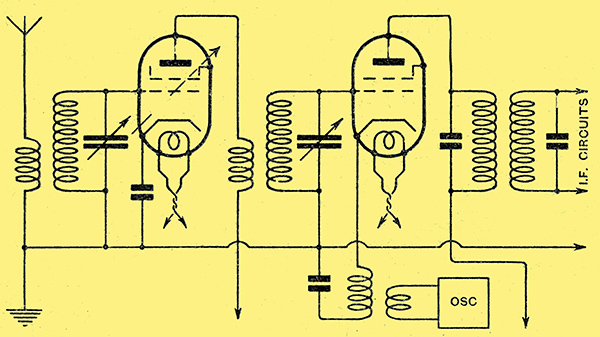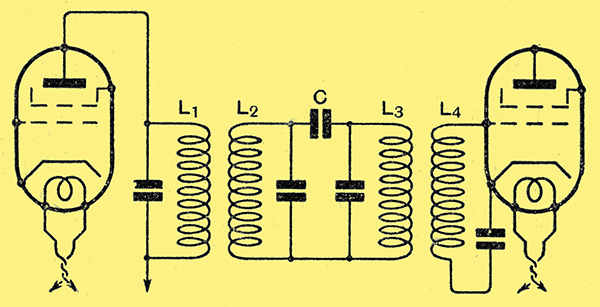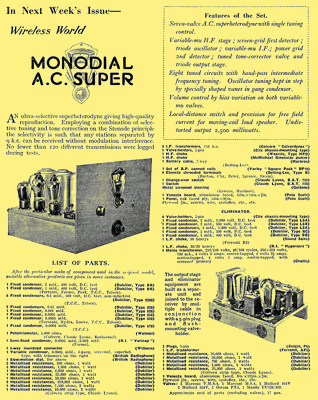|
A Summary of the Tendencies in Modern Design.
In this authoritative study of the latest trend in superheterodyne design the is author foreshadows some notable developments of the greatest interest to amateurs. In the clearest terms it is shown that for as modern superheterodyne to be free from background noise and modulation interference a signal-frequency amplifying stage with a variable-mu valve is almost essential. high degree of selectivity and quality is ensured by the inclusion of selective tuning circuits together with a tone correcting valve, on the Stenode principle.
The popularity of the various superheterodynes which have been described in The Wireless World has sufficed to show that the way in which they fulfil the modern need for a highly sensitive and selective receiver, which is also capable of giving first-class quality of reproduction, is greatly appreciated. Since these receivers were designed, however, development in radio has proceeded apace - variable-mu valves have been introduced, single-dial tuning systems have been simplified, and the possibility of highly selective filters used in conjunction with tone correction on the lines of the Stenode has come to be recognised. The net result is that enormous scope has been presented for improvement in superheterodyne technique.
One of the most serious difficulties attendant upon superheterodyne design has always been the elimination of background noise. It has recently been pointed out by the present writer [★] Background Noises, The Wireless World, December 30, 1931. that for a minimum of background noise the aerial circuit should be as efficient as possible. Logically, therefore, a single tuned aerial circuit should be employed, and used with optimum coupling to an efficient aerial. Both theory and practice show, however, that at least two tuned circuits must be used to precede the first detector if second channel and other special sources of interference [★] Why The Whistles? The Wireless World, March 9, 1932. are to be reasonably small, It is only possible to employ a single tuned aerial circuit and still have two tuned circuits before the first detector if a preliminary stage of HF amplification be used.
The oscillator is one of the chief sources of background noise [★] The Intermediate Frequency Amplifier of the Superheterodyne, by A L M Sowerby, MSc, The Wireless World, December 17, 1930., however, and, as a result, it is found that the lower the value of IF amplification the lower is the noise level. If the IF amplification be reduced to such a value that the background noise is negligible, however, the sensitivity of the set suffers seriously, and in order to maintain the overall amplification it is necessary to add a stage of amplification preceding the first detector. It will thus be seen that on two counts a preliminary stage of HF amplification is desirable, for in two different ways it helps to keep the background noise generated within the receiver at a low level.
The Variable-mu Valve
It has previously been pointed out, however [★] The Selectivity of the Superheterodyne, The Wireless World May 13 and 20, 1931., that preliminary HF amplification cannot be used with ordinary screen-grid valves on account of the cross-modulation which occurs at short distances from modern high power transmitters, and it has been for this reason that earlier designs have not included such a stage of amplification. The variable-mu valve has characteristics much less curved than those of any other screen-grid valve, and as a result it is less prone to cross-modulation. The reduction in cross-modulation, in fact, is so great that in most cases its possibility can be ignored. Provided that variable-mu valves are employed, therefore, a stage of preliminary HF amplification is now practicable, and full advantage can be taken of its capabilities in reducing background noise.
Still another advantage results from the use of variable-mu valves, and this is in connection with the volume control, a feature which has always presented considerable difficulty in superheterodynes. It is, of course, essential to use a control which acts to reduce both the signal input to the first detector and the value of the IF amplification, and such a control has hitherto often necessitated the employment of ganged potentiometers. Where variable-mu valves are used in both the preliminary HF stage and in the IF stage, however, this dual control can readily be obtained by varying their grid bias voltages simultaneously by a single potentiometer.

Fig. 1 - The essential circuit, shorn of unnecessary detail, of the early stages of a modern superheterodyne. A single tuned circuit precedes the preliminary signal-frequency amplifier and a variable-mu valve is used.
It will be seen, therefore, that an up-to-date superheterodyne would include a preliminary HF stage with a low gain IF stage. Variable-mu valves would be used with volume control by variation of their bias voltage, and two tuned circuits would precede the first detector. A skeleton circuit of the early stages of such a receiver would take the form shown in Fig. 1, where details not of fundamental importance are omitted.
The IF Circuits
Some attention must now be devoted to the question of adjacent channel selectivity, for this is obtained largely in the IF circuits, and it will be assumed that the actual frequency employed is the value of 110 kHz., which has been standardised by The Wireless World. There are two main methods by which high selectivity can be obtained without a sacrifice in quality. In a superheterodyne, band-pass filters which give a fiat-topped resonance curve over a range of 5 kHz on either side of resonance combined with a very sharp cut-off outside that limit can be used. Alternatively, it is possible to use very selective and sharply tuned. circuits, and ignore the sideband cutting which will inevitably take place; the quality can then be restored by the use of tone correction in the LF circuits, and this is, in fact, the principle which has been adopted in the Stenode Radiostat method of reception.
Before deciding which is the better method to employ at the present time, it is as well to examine carefully the factors involved. It is fairly generally known that freedom from modulation interference can be secured by the use of a linear second detector, provided that at the detector the ratio of the carrier of the wanted station to that of the unwanted station is sufficiently high. The problem, therefore, resolves itself into a consideration. of the methods whereby the necessary selectivity can be achieved.
Now, when stations are spaced by 9 kHz and it is desired to reproduce audio frequencies up to 5 kHz only, either band-pass filters or ultra-selective circuits with tone correction can be used without affecting the final result, for with either method it is possible to obtain the requisite ratio of wanted to unwanted signal voltages. It should be pointed out that tone correction is theoretically capable of the better results, for there is no necessity as regards modulation interference for imposing the foregoing upper limit to the overall frequency response, nor is there theoretically any limiting factor to the frequency separation of stations. Unfortunately, however, modulation interference is the least serious trouble encountered at the present time.
Heterodyne Interference
With any method of reception, limits to the frequency response are imposed by the necessity for avoiding heterodyne interference, for there is no known method by which heterodyne whistles may be removed without also removing musical notes of the same frequency. With a 9 kHz station separation, therefore, a tone-corrected set is capable of reproducing frequencies up to about 8 kHz only, for the elimination of the whistle caused by the heterodyne note between adjacent carriers. A greater problem is set by sideband heterodyning, however, for even with a 9 kHz station separation, momentary audible beats may occur at almost any frequency within the audible range.
Fortunately, however, by far the greater proportion of the audible beats occur at frequencies higher than 5 kHz, and they may consequently be eliminated by deliberately cutting off these higher frequencies. It will be seen, therefore, that whatever method of reception be employed, frequencies higher than 5 kHz cannot be reproduced without running into the danger of a serious amount of interference due to sideband heterodyning. The position may be summarised in a few, words: frequencies higher than 5 kHz cannot be reproduced with band-pass filters, firstly, because it is impracticable to obtain freedom from modulation interference if the response be made higher; and secondly, because oi the necessity for securing reasonable freedom from sideband heterodyning, frequencies higher than 5 kHz cannot be reproduced with a tone-corrected receiver because of sideband heterodyning.
It will be clear, therefore, that with the present broadcasting conditions either method of tuning may be employed with no theoretical difference to the ultimate results. Should a method of eliminating heterodyne whistles be evolved, however, there can be no doubt that the principle of tone correction would, ultimately supersede the band-pass circuit. In the absence of any such method, however, we are at liberty to choose the tuning system on grounds other than those of pure selectivity.
Now, band-pass tuning is rather more familiar than tone correction, and the required flat-topped resonance curve can readily be obtained. It is exceedingly difficult, however, to secure both the flat-topped resonance curve and sufficient selectivity to render modulation interference negligible with a reasonable number of tuned circuits and an economical construction.
Difficulties of this nature do not arise with tone correction, and it is readily possible to make the adjacent channel selectivity as high as desired. It is not usually practicable to obtain the required selectivity from a single circuit of very low decrement, however, and when it is obtained by means of a number, of cascade circuits, it becomes comparatively difficult to secure sufficient tone correction for the sideband cutting. A single tuned circuit at 110 kHz for instance, may easily reduce a 5 kHz note to one-tenth of its normal value, and three such circuits in cascade will reduce it to one-thousandth. The LF circuits, therefore, must amplify a 5 kHz note 1,000 times as much as as 50 Hz note to secure the proper balance between bass and treble.
Now, an amplification of 1,000 times cannot be secured from a single stage of LF amplification, and it will be seen that it would be necessary, to employ two stages of tone correction, and this would add considerably to the cost of the receiver. It will, of course, be realised that these remarks apply only to the case where cascade circuits are used, for if the selectivity be obtained by means of a single very sharply tuned circuit the case is entirely different. Provided that the selectivity exceeds a certain figure, at fixed compensation ratio of 100:1 is needed for the frequency range of 5k - 50 Hz, and this is more readily obtainable.
Band-pass to Avoid Critical Tuning
All sharply tuned circuits suffer from one disadvantage, however, when they are employed in a mains- operated superheterodyne the tuning is exceedingly critical. This is not in itself a disadvantage, but, as the tuning is effectively carried out by the adjustment of the oscillator frequency, it will be seen that if the oscillator frequency wanders during reception, the set will be thrown out of tune. In a sharply tuned mains superheterodyne, therefore, it may be found that fluctuations in the mains voltage, which would normally pass unnoticed, have the effect of detuning the receiver.
It will thus be seen that neither band-pass tuning nor tone correction is alone perfect in a superheterodyne. Both theory and practice show, however, that a judicious combination of the two is eminently suitable, and that by this combination the disadvantages of each are removed. If, for instance, a band-pass filter is built which will give at flat-topped resonance curve over a range of only some 2 kHz on either side of resonance, enormously high adjacent channel selectivity can be obtained, while the circuits are not so sharply tuned that fluctuations in the mains voltage have any serious effect.
With such a filter, frequencies of 5 kHz are reduced to about one eighth of their correct value, and so a single tone corrector or stage designed to amplify 5 kHz notes eight times as much as 50 Hz notes will allow of a flat overall response curve being obtained. A special design of the tone corrector is, of course, necessary for, as the IF circuits pass frequencies up to 2 kHz without attenuation, the LF characteristics must also be flat for frequencies between 50 Hz and 2 kHz. The design of suitable circuits, however, is not difficult, and the arrangement is eminently practical. Suitable types of tone corrector are very simple and inexpensive. It is usually the design of the band-pass filter which is more complicated, but a suitable type has been evolved, and it consists of a four-stage filter, as shown in Fig. 2, used in conjunction with the now familiar two-stage type.

Fig. 2. - A four-stage band-pass filter for the intermediate-frequency amplifier used in conjunction with an LF tone correcting stage.
The four-stage filter consists of two pairs of mutually coupled coils. L1, L2 and L3, L4, and the two coils L2 and L3 are loosely coupled together by means of a small capacitor C.
It will be seen, therefore, that it is readily possible to build a superheterodyne which will permit of selectivity being obtained which is so high that for most purposes modulation interference may be said to be non-existent. Such a receiver may be given also an overall frequency response so good that the quality of reproduction is practically indistinguishable from that given by a purely local station quality receiver. In addition, the various other improvements which have taken place have permitted the introduction of a distortion-less volume control and of the reduction of background noise to a point where it is inaudible on most transmissions.
These features represent an important advance in receiver design, and this is particularly the case when it is remembered that they are accompanied by a simplified construction, adjustment, and operation of the set. A receiver has been designed which embodies the points which have been discussed in this article, and on test it has fully proved the various theoretical details involved. It will be described here.

The advert from April 6, 1932.
|